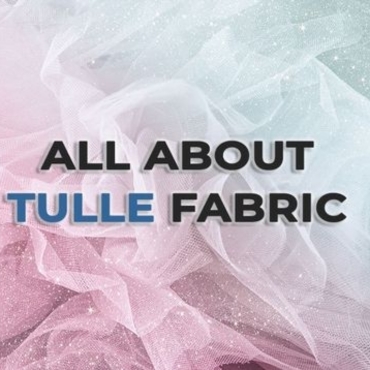Have you thought about why bridal veils are so soft and fluffy, or how tutus hold their form so flawlessly? The answer is tulle, a type of net-like material that is lightweight. What is tulle fabric? To put it simply, it is a fine sheer mesh fabric made of material used for weddings, fashion, and even decorations. It adds beauty without weight.
Whether you are a fashion designer or a DIY enthusiast, this guide will explain everything about tulle—its types, uses, and care tips. You will find valuable insights here.
Table of contents
What Is Tulle Fabric? Definition & Characteristics

Tulle is a lightweight, transparent textile comparable to fine netting. It is created by weaving yarn in a hexagonal pattern, producing small holes that impart a soft and delicate feel.
Tulle is different from other fabrics because it combines softness with stiffness. It maintains its shape which is perfect for extravagant designs. It is used in wedding dresses, ballet tutus, and also in party decorations.
Important Aspects of Tulle Fabric
- Sheerness: Its dreamy effect comes from its see-through quality.
- Versatility: Perfect or fashion, décor, and crafts, tulle fabric can do it all.
- Lightweight: Doesn’t weigh down garments.
- Stiffness: Holds its shape, perfect for puffy designs.
Now that we learned the basics. Let’s move on to its different types.
Types of Tulle Fabric

Tulle comes in various materials, but here are the most common types:
The Most Luxurious – Silk Tulle
Designers often use silk tulle for high-end bridal wear. It is the finest and most expensive type, feeling incredibly soft and draping beautifully.
Breathable & Natural – Cotton Tulle
Softer than synthetic fabrics, cotton tulle is more breathable, making it great for summer outfits; however, it wrinkles easily.
Affordable & Durable – Nylon Tulle
Focusing on budget-friendly options? Then, nylon tulle is your best fit. It’s widely available, strong, holds its shape well, and resists wrinkles, making nylon the go-to fabric for tutus and veils.
Common & Versatile – Polyester Tulle
Polyester tulle is the most popular for a reason. Cheaper compared to the others, it is also very durable and comes in many different colors, however, it lacks the softness of silk or cotton.
Glitter Tulle (Sparkly & Festive)
Glitter tulle is a type of fabric that has shiny or glittery threads woven into it. It is ideal for use in party dresses, costumes, and festive decorations.
Illusion Tulle (Ultra-Sheer & Soft)
This type is virtually transparent and appears in most bridal veils. Designers often use it to make veils.
Identifying different types aids in determining the correct tulle to incorporate into your design.
Popular Uses of Tulle Fabric

Although most people think of tulle as a fabric for wedding veils, it can have as many uses as one can imagine. This is how people use tulle in fashion, décor, and a lot more.
Bridal Wear (Veils, Gowns & Accessories)
Tulle has a romantic appearance which makes imbuing gowns difficult for designers, therefore creating ethereal skirts and overlays is much easier. That’s not to mention its use in veils.
Ballet Costumes & Tutus
The lightweight stiff nature of tulle fabric means ballet dancers can wear tulle tutus for ease of movement while still looking elegant.
Centerpieces, Balloons & Party Decorations
Since gifts give off a whimsical nature, people often use tulle to wrap gifts and decorate parties. People also implement it while decorating arches or draping backdrops.
Ruffles, Sleeves, Layering & Embellishments
A lot of dresses have sleeve and ruffle tulle embellishments for adding volume. It also serves well as an underskirt to create fullness.
Home Décor, Bows, Wreaths & Hair Accessories
People often use tulle to wrap gifts and decorate parties because it gives off a whimsical feel.
Tulle is incredibly versatile as you can see, and incredibly flexible as well but what about tulle maintenance?
How to Take Care of tulle
Tulle is a delicate fabric and for it to look new, it needs gentle care. To maintain its beauty, follow the tips below.
Washing Tulle (Hand Wash or Gentle Cycle)
Use cold water only to stop shrinkage.
Tulle should be washed with a mild detergent and not chemicals.
If machine washing, place tulle in a mesh bag.
Drying Tulle (Air Dry Only)
Heat could warp or melt the fabric, so the dryer should never be used.
It could be laid flat to dry or hung.
Ironing & Steaming (Low Heat Required)
A steamer should be kept at a distance but works better than an iron.
Use a cloth when pressing down on the fabric, and set the iron to the lowest setting.
Storing Tulle (Avoid Moisture & Direct Sunlight)
While caring for tulle, one should keep it in a cool and dry space.
Sharp objects can cause snags, so keep them away from the fabric.
The tulle will stay intact with the right amount of care.
Prons and Cons of Tulle Fabric
Tulle certainly has it’s pros and cons and that is why before using it, think carefully.
PROS:
- Very light and allows air to flow through it
- Keeps its form
- Readily available in endless colors and styles
- Relatively cheap unless satin silk tulle is used
CONS:
- Rips quite easily
- Some of the tulle may be uncomfortable
- Use it with caution
Needs no explanation, but tulle does have some flaws, it truly is the best selection for a lot of tasks.
Conclusion
As we saw, tulle fabric is widely popular based on its uses. From party decorations to bridal veils, it is without a doubt elegant and enhances every project.
Do not forget that every tulle type comes with its own advantages. There are advantages in silk tulle, as it is luxury. Glitter tulle gives shine and polyester is cost effective.
Your creations will stay beautiful for many years if you take proper care of them. Therefore, whether you are decorating an event or sewing a gown, tulle is an amazing selection.
FAQs
Some stiff tulle can feel scratchy. For comfort, choose silk or cotton tulle.
Yes, but synthetic tulle requires special dyes. Always test a small piece first.
Tulle is finer and softer, while netting has larger holes and is stiffer.
Use sharp scissors for clean cuts. You can also lightly singe synthetic tulle edges.



Great breakdown on tulle! I’ve always been curious about the different types—especially the difference between silk tulle and nylon tulle. The care tips were also super helpful; I’ve definitely made the mistake of machine-washing it before.
I love how you broke down the different types of tulle! I’ve always wondered why some wedding veils feel softer than others—turns out it’s all about the type of tulle used.
Nice overview! One thing that stood out to me was how versatile tulle is—going from ballerina tutus to modern fashion layers. A section on sustainable tulle options might be an interesting addition too.
I appreciated the breakdown of tulle types and care instructions—it’s easy to overlook how delicate this fabric can be until it snags! Curious to know if there are eco-friendly alternatives that still give that same lightweight look?
Great breakdown on tulle fabric! I didn’t realize how much variety there was in texture and stiffness, especially how that affects its application in fashion.
I’ve worked with tulle in some DIY projects, and it’s definitely a tricky material if you’re not familiar with its properties. The care section in your post really nails what beginners should watch out for.
I loved the tips on caring for tulle – I’ve always struggled to keep it looking fresh. Definitely going to use the suggestion to hand wash and avoid excessive heat!
I work with a lot of stage costumes, so learning about the different types of tulle is really helpful. Not all tulles behave the same under lights or movement, so this kind of info is gold.